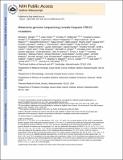Melanoma genome sequencing reveals frequent PREX2 mutations
Author(s)
Berger, Michael F.; Hodis, Eran; Heffernan, Timothy P.; Deribe, Yonathan Lissanu; Lawrence, Michael S.; Protopopov, Alexei; Ivanova, Elena; Watson, Ian R.; Nickerson, Elizabeth; Ghosh, Papia; Zhang, Hailei; Zeid, Rhamy; Ren, Xiaojia; Cibulskis, Kristian; Sivachenko, Andrey Y.; Wagle, Nikhil; Sucker, Antje; Sougnez, Carrie; Onofrio, Robert; Lander, Eric Steven; ... Show more Show less
DownloadLander_Melanoma genome.pdf (948.4Kb)
OPEN_ACCESS_POLICY
Open Access Policy
Creative Commons Attribution-Noncommercial-Share Alike
Terms of use
Metadata
Show full item recordAbstract
Melanoma is notable for its metastatic propensity, lethality in the advanced setting and association with ultraviolet exposure early in life. To obtain a comprehensive genomic view of melanoma in humans, we sequenced the genomes of 25 metastatic melanomas and matched germline DNA. A wide range of point mutation rates was observed: lowest in melanomas whose primaries arose on non-ultraviolet-exposed hairless skin of the extremities (3 and 14 per megabase (Mb) of genome), intermediate in those originating from hair-bearing skin of the trunk (5–55 per Mb), and highest in a patient with a documented history of chronic sun exposure (111 per Mb). Analysis of whole-genome sequence data identified PREX2 (phosphatidylinositol-3,4,5-trisphosphate-dependent Rac exchange factor 2)—a PTEN-interacting protein and negative regulator of PTEN in breast cancer—as a significantly mutated gene with a mutation frequency of approximately 14% in an independent extension cohort of 107 human melanomas. PREX2 mutations are biologically relevant, as ectopic expression of mutant PREX2 accelerated tumour formation of immortalized human melanocytes in vivo. Thus, whole-genome sequencing of human melanoma tumours revealed genomic evidence of ultraviolet pathogenesis and discovered a new recurrently mutated gene in melanoma.
Date issued
2012-05Department
Massachusetts Institute of Technology. Department of Biology; Whitehead Institute for Biomedical ResearchJournal
Nature
Publisher
Nature Publishing Group
Citation
Berger, Michael F., Eran Hodis, Timothy P. Heffernan, Yonathan Lissanu Deribe, Michael S. Lawrence, Alexei Protopopov, Elena Ivanova, et al. “Melanoma genome sequencing reveals frequent PREX2 mutations.” Nature (May 9, 2012).
Version: Author's final manuscript
ISSN
0028-0836
1476-4687